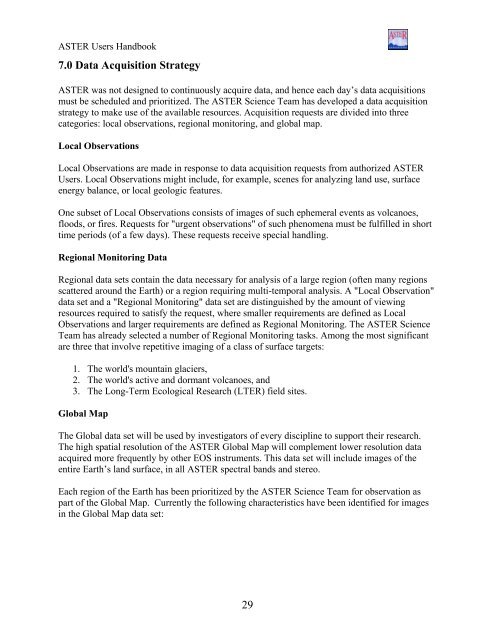Create successful ePaper yourself
Turn your PDF publications into a flip-book with our unique Google optimized e-Paper software.
<strong>ASTER</strong> Users Handbook7.0 Data Acquisition Strategy<strong>ASTER</strong> was not designed to continuously acquire data, and hence each day’s data acquisitionsmust be scheduled and prioritized. The <strong>ASTER</strong> Science Team has developed a data acquisitionstrategy to make use of the available resources. Acquisition requests are divided into threecategories: local observations, regional monitoring, and global map.Local ObservationsLocal Observations are made in response to data acquisition requests from authorized <strong>ASTER</strong>Users. Local Observations might include, for example, scenes for analyzing land use, surfaceenergy balance, or local geologic features.One subset of Local Observations consists of images of such ephemeral events as volcanoes,floods, or fires. Requests for "urgent observations" of such phenomena must be fulfilled in shorttime periods (of a few days). These requests receive special handling.Regional Monitoring DataRegional data sets contain the data necessary for analysis of a large region (often many regionsscattered around the Earth) or a region requiring multi-temporal analysis. A "Local Observation"data set and a "Regional Monitoring" data set are distinguished by the amount of viewingresources required to satisfy the request, where smaller requirements are defined as LocalObservations and larger requirements are defined as Regional Monitoring. The <strong>ASTER</strong> ScienceTeam has already selected a number of Regional Monitoring tasks. Among the most significantare three that involve repetitive imaging of a class of surface targets:1. The world's mountain glaciers,2. The world's active and dormant volcanoes, and3. The Long-Term Ecological Research (LTER) field sites.Global MapThe Global data set will be used by investigators of every discipline to support their research.The high spatial resolution of the <strong>ASTER</strong> Global Map will complement lower resolution dataacquired more frequently by other EOS instruments. This data set will include images of theentire Earth’s land surface, in all <strong>ASTER</strong> spectral bands and stereo.Each region of the Earth has been prioritized by the <strong>ASTER</strong> Science Team for observation aspart of the Global Map. Currently the following characteristics have been identified for imagesin the Global Map data set:29















